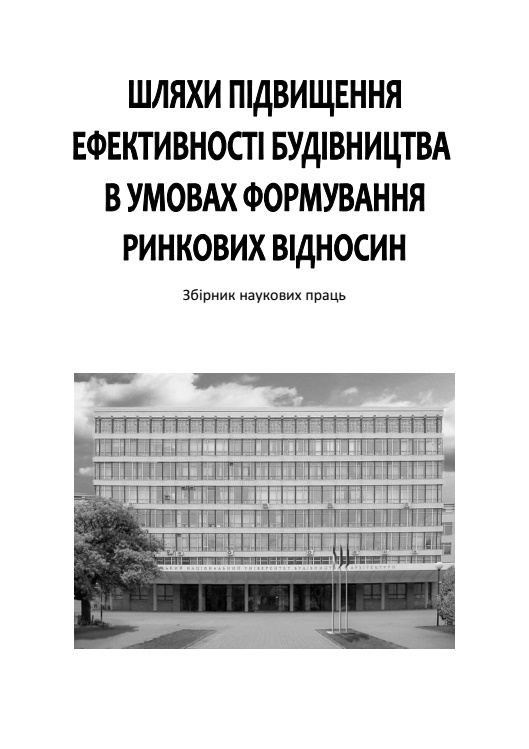Problems and disadvantages of the existing evaluation system of thermomodernization projects of construction objects
DOI:
https://doi.org/10.32347/2707-501x.2021.47(1).119-128Keywords:
thermal modernization, construction organization, construction administration, realization of thermal modernization projectsAbstract
The article considers the topical issue of thermal modernization of residential buildings and social facilities is an important area of research, but in the implementation of such projects there are many obstacles of organizational and administrative nature, which currently hinder the implementation of projects to improve energy efficiency of buildings and structures. and the systematization of which will allow to develop measures to eliminate existing barriers, and thus improve the attractiveness and accessibility of thermal modernization projects for the population and other stakeholders.
The main stages of thermal modernization are systematized in accordance with the provisions of the current legislative and regulatory framework, the place of thermal modernization measures in the sequence of implementation of investment and construction projects is determined.
It is determined that the main types of construction in which thermal modernization is carried out are capital repairs, reconstruction and technical re-equipment, but thermal modernization measures can be carried out during the current repair. Current repairs are not a type of construction, and therefore it is not subject to laws and regulations in the field of construction, and therefore the organization and implementation of such works from the standpoint of the requirements of legislation and regulations is the simplest.
The following obstacles and barriers were identified during the development of the thermal modernization project, namely: the order of performance of the technical condition survey and energy audit is not legally established (in practice these are two unrelated actions, the result of which are not related technical reports analyzed by the designer. design), the stages of thermal modernization are not linked to a single methodology, given in separate documents, and therefore require special professional knowledge, not sufficiently reflected stages of preparation of thermal modernization at the stage of pre-design work, while at this stage decisions must be made , providing the required level of energy efficiency for the customer, technical and economic indicators of the project.
References
Закон України «Про енергетичну ефективність будівель» від 22.06.2017 № 2118-VIII. Режим доступу: https://zakon.rada.gov.ua/laws/show/2118-19.
Наказ №260 від 27.09.2020 р. Про затвердження Мінімальних вимог до енергетичної ефективності будівель». Режим доступу: https://zakon.rada.gov.ua/laws/show/z1257-20/print
Наказ №261 від 27.10.2020 р. «Про затвердження Змін до Методики визначення енергетичної ефективності будівель». Режим доступу: https://zakon.rada.gov.ua/laws/show/z1254-20/print
ДСТУ-Н Б В.3.2-3:2014. Настанова з виконання термомодернізації житлових будинків. К.: ДП «Архбудінформ», 2015.
ДСТУ-Н Б А.2.2-13: 2015 «Енергетична ефективність будівель. Настанова з проведення енергетичної оцінки будівель». Режим доступу: http://bit.do/ftWBP
ДБН В.2.6–31:3006 «Теплова ізоляція будівель». К.: Мінрегіонбуд, 2006.
Енергоефективність в муніципальному секторі. Навчальний посібник для посадових осіб місцевого самоврядування / Максимов А.С. та інші. AMU, USAID, 2015. 184 с.
Бєлєнкова О.Ю. Економічна оцінка заходів з підвищення енергоефективності / О.Ю. Бєлєнкова, Т.Ю. Цифра, О.В. Мацапура, І.О. Остапенко // Шляхи підвищення ефективності будівництва в умовах формування ринкових відносин, Вип. 36, 2018 – С.78–82.
Максимов А.С. Техніко-економічне обґрунтування заходів з підвищення енергоефективності об’єктів невиробничого призначення. «Зелена» економика – шлях до сталого розвитку: зб. матеріалів / А.С. Максимов, В.М. Довганюк, І.В. Вахович, Т.Ю. Цифра. К.: 2013. 113–117.
Ізмайлова К.В. Екологічний супровід запасів як чинник ефективності використання оборотних засобів будівельного підприємства [Текст] /К.В. Ізмайлова // Шляхи підвищення ефективності будівництва в умовах формування ринкових відносин, 2018. – № 36. – С. 3 – 7.
Бєлєнкова О.Ю. Економічна оцінка заходів з підвищення енергоефективності/ О.Ю. Бєлєнкова, І.О. Остапенко // Будівельне виробництво. – 2013. – Вип. 55. – С.28 – 31.
Бєлєнкова О.Ю., Терлецький О.І. Оцінка матеріалів утеплення стін за допомогою програми RetScreen. Будівельне виробництво. 2012. Вип. 54. С.16 – 20.
Бєлєнкова О.Ю. Тенденції розвитку будівельної галузі як чинники формування стратегічної конкурентоспроможності будівельних підприємств. Будівельне виробництво. 2014. Вип. 57. С. 24–30.
Ізмайлова К.В. Регресивна модель впливу проектних рішень на енергоефективність будівлі Шляхи підвищення ефективності будівництва в умовах формування ринкових відносин. 2020. № 44. С. 108–115.
Абашкина К.О. Ізмайлова К.В. Обгрунтування економічної доцільності встановлення сонячних батарей на заміських житлових будинках, Будівельне виробництво. 2017 № 62/2
Звіт про науково-дослідну роботу "Дослідження та розробка науково-обґрунтованої методології щодо вибору заходів з підвищення енергетичної ефективності житлових і громадських будівель та розрахунку обсягу зекономлених енергетичних ресурсів і коштів в результаті їх впровадження" договір № Н-6/447-2012 від 07.12.2012 р. – К.:ДП НДІБВ, 2013
Звіт про науково-дослідну роботу «Проведення аналітичних досліджень та розробка принципових будівельно-технічних рішень щодо проведення комплексної термомодернізації будинків загальноосвітніх шкіл бюджетного утримання (на прикладі 6 проектів) з обґрунтуванням доцільності для повторного застосування» договір № Н-14/296-2012 від 24.10.2012. – К.:ДП НДІБВ, 2013
Підготовка проектних пропозицій із чистої енергії: практичний посібник / Під загальною редакцією Тормосова Р.Ю., Романюк О.П., Сафіуліної К.Р. – К.:ТОВ «Поліграф плюс», 2015. 176 с.
Eric Woodroof, Ph.D., and Albert Thumann, P.E., C.E.M. How to finance energy management projects. – Fairmont Press, 2014. – 390 p.
Downloads
Published
How to Cite
Issue
Section
License

This work is licensed under a Creative Commons Attribution 4.0 International License.
Authors who publish with this journal agree to the following terms:
- Authors retain copyright and grant the journal right of first publication with the work simultaneously licensed under a Creative Commons Attribution License that allows others to share the work with an acknowledgement of the work's authorship and initial publication in this journal.
- Authors are able to enter into separate, additional contractual arrangements for the non-exclusive distribution of the journal's published version of the work (e.g., post it to an institutional repository or publish it in a book), with an acknowledgement of its initial publication in this journal.
- Authors are permitted and encouraged to post their work online (e.g., in institutional repositories or on their website) prior to and during the submission process, as it can lead to productive exchanges, as well as earlier and greater citation of published work (See The Effect of Open Access).

